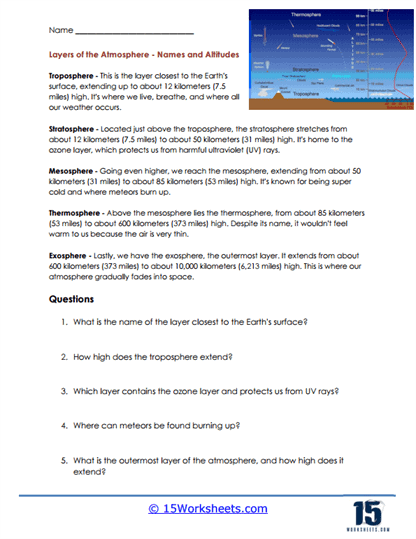Names and Altitudes

Worksheet Description
The worksheet provides an informative breakdown of the various layers of Earth’s atmosphere, detailing their respective altitudes and unique characteristics. Starting with the troposphere, the layer closest to Earth’s surface, and extending to the exosphere, the outermost layer, the sheet elucidates the specific altitudes, properties, and phenomena associated with each atmospheric layer. Accompanied by a visual representation, this resource offers clear insights into how these layers are stratified above our planet. A set of questions at the bottom further challenges learners to recall and apply the knowledge they’ve garnered from the text.
To effectively engage with this worksheet, students should first take a moment to review the visual diagram, noting the divisions and relative positions of the atmospheric layers. Following this, a thorough reading of the textual descriptions will equip them with details about each layer’s altitudes and characteristics. With this information in hand, students can then proceed to answer the provided questions, referencing both the diagram and the text for accurate responses. To reinforce understanding, learners may consider discussing their insights with classmates or educators, comparing answers and deepening their grasp on the topic.
This worksheet is designed to impart a comprehensive understanding of the Earth’s atmospheric layers and their distinct attributes. By providing detailed descriptions and clear visual aids, it aims to familiarize students with the names, altitudes, and unique features of each layer, from the troposphere to the exosphere. The resource emphasizes the importance of understanding the atmospheric structure to better comprehend various meteorological and environmental phenomena. Through the accompanying questions, it further cultivates analytical skills and promotes critical thinking, ensuring students not only absorb the information but also develop the ability to apply it in varied contexts.
